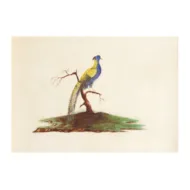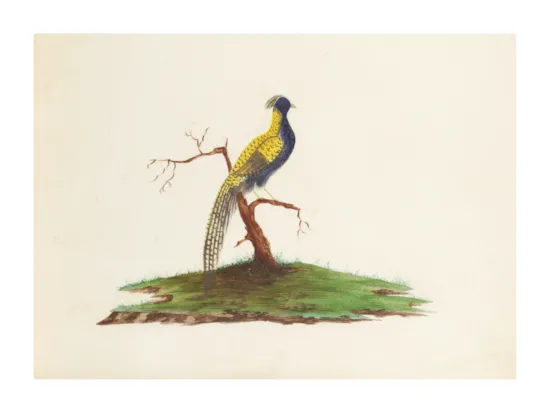Sarah Stone (1760 - 1844)
UNIDENTIFIED PHEASANTS
Unsigned.
These two paintings present a variety of problems. They both appear to be images of some kind of exotic pheasant but they do not quite conform to any known species. This is not necessarily significant as pheasant species frequently hybridise.
The two paintings are very similar, however they are not quite identical, and there are several small, almost insignificant differences.
Perhaps the most extraordinary aspect of the pair is that one was stuck to the back of the other, and it is only by the skill of a conservator that they were separated. Whatever this means cannot now be said and the fact that they are unsigned and undated serves only to increase the enigma.
Unsigned.
These two paintings present a variety of problems. They both appear to be images of some kind of exotic pheasant but they do not quite conform to any known species. This is not necessarily significant as pheasant species frequently hybridise.
The two paintings are very similar, however they are not quite identical, and there are several small, almost insignificant differences.
Perhaps the most extraordinary aspect of the pair is that one was stuck to the back of the other, and it is only by the skill of a conservator that they were separated. Whatever this means cannot now be said and the fact that they are unsigned and undated serves only to increase the enigma.
UNIDENTIFIED PHEASANTS
Unsigned.
These two paintings present a variety of problems. They both appear to be images of some kind of exotic pheasant but they do not quite conform to any known species. This is not necessarily significant as pheasant species frequently hybridise.
The two paintings are very similar, however they are not quite identical, and there are several small, almost insignificant differences.
Perhaps the most extraordinary aspect of the pair is that one was stuck to the back of the other, and it is only by the skill of a conservator that they were separated. Whatever this means cannot now be said and the fact that they are unsigned and undated serves only to increase the enigma.
Unsigned.
These two paintings present a variety of problems. They both appear to be images of some kind of exotic pheasant but they do not quite conform to any known species. This is not necessarily significant as pheasant species frequently hybridise.
The two paintings are very similar, however they are not quite identical, and there are several small, almost insignificant differences.
Perhaps the most extraordinary aspect of the pair is that one was stuck to the back of the other, and it is only by the skill of a conservator that they were separated. Whatever this means cannot now be said and the fact that they are unsigned and undated serves only to increase the enigma.
The story of Miss Sarah Stone 1760 – 1844, a woman who achieved commercial success as an artist at a time when such achievement was usually denied to females. Like many ladies who painted during the era in which she lived, Miss Stone produced exquisite paintings in watercolour. However she was almost unique in that she enjoyed a considerable amount of commercial success ! Her paintings didn’t just stay on the walls of friends or relatives, they were actively sought after by connoisseurs and collectors alike. In an age when the efforts of women were often disregarded or even entirely dismissed she ‘bucked the trend’ and stood out as a woman who ‘mattered’. In this way she might be compared to her slightly later contemporary Mary Anning, the woman from Lyme Regis who kick-started the science of palaeontology. Like the activities of Miss Anning, Sarah Stone’s watercolours became of enormous historical and scientific value.
What was it about her that stood out from the rest ? Firstly, she was highly skilled and produced beautiful images of birds, mammals, fish, insects, shells, minerals and ethnological objects when such curiosities were being brought back for the first time from far corners of the world. In many cases the images she produced are the only records that now remain of the important treasures being brought back to Britain on significant and highly celebrated exploratory voyages, most famously those of Captain Cook. So her watercolours form a unique record of discoveries that in many respects changed the world.
Secondly, she was remarkably industrious and painted almost every day. The daughter of a painter of fans, she was largely self-taught and began her career at an early age. Although many of her paintings survive, almost all now exist only in museums and galleries from which they will never be released. Only a very few remain in private hands, which is why the emergence of this remarkable collection of no less than 23 watercolours is so surprising. And what a collection it is, containing highly detailed paintings of exotic birds that were being seen in Britain for the first time in the days when Sarah painted them. It may be asked, ‘how did she get access to such rare and valued items’ ? The answer is simple, when she was still a young lady, she was commissioned by Sir Ashton Lever, owner of the celebrated Leverian Museum to paint some of his most interesting objects. She fulfilled her obligations in stunning and beautiful ways, and it was just as well that she did, for the entire Leverian collection was dispersed at an auction that took place in 1806, and many of the items were lost forever.
The remarkable collection of newly discovered watercolours will, of course, only be temporary, however a more permanent record will live on in the form of this new publication for years to come.
What was it about her that stood out from the rest ? Firstly, she was highly skilled and produced beautiful images of birds, mammals, fish, insects, shells, minerals and ethnological objects when such curiosities were being brought back for the first time from far corners of the world. In many cases the images she produced are the only records that now remain of the important treasures being brought back to Britain on significant and highly celebrated exploratory voyages, most famously those of Captain Cook. So her watercolours form a unique record of discoveries that in many respects changed the world.
Secondly, she was remarkably industrious and painted almost every day. The daughter of a painter of fans, she was largely self-taught and began her career at an early age. Although many of her paintings survive, almost all now exist only in museums and galleries from which they will never be released. Only a very few remain in private hands, which is why the emergence of this remarkable collection of no less than 23 watercolours is so surprising. And what a collection it is, containing highly detailed paintings of exotic birds that were being seen in Britain for the first time in the days when Sarah painted them. It may be asked, ‘how did she get access to such rare and valued items’ ? The answer is simple, when she was still a young lady, she was commissioned by Sir Ashton Lever, owner of the celebrated Leverian Museum to paint some of his most interesting objects. She fulfilled her obligations in stunning and beautiful ways, and it was just as well that she did, for the entire Leverian collection was dispersed at an auction that took place in 1806, and many of the items were lost forever.
The remarkable collection of newly discovered watercolours will, of course, only be temporary, however a more permanent record will live on in the form of this new publication for years to come.
By gift or descent to Frances Smith Beale (1800-1849), the artist’s niece, daughter of Frances Mary Stone (1769-1852), sister of the artist; By descent to Ellen Beale Brooker d. 1900, (m. in 1868 William Watkiss Lloyd, 1813-1893); By descent to Eireene Watkiss Lloyd; daughter of the above, m. William Dockar Drysdale (1866-1952) of Wick Hall, Radley, Oxfordshire; by descent to (William) Patrick Dockar Drysdale (1929-2020), Wick Hall, Radley from 1982
Ex Private collection
Ex Private collection
It is with great pleasure that I present the new book Sarah Stone, Unseen Worlds, A Rare Collection of 18th Century Watercolours. Written together with Errol Fuller, the book presents a collection of 23 watercolours that I have only very recently discovered in the estate of one of Sarah Stone’s descendants. Sarah Stone earned fame in her day for her watercolours of scientific specimens, that she painted at the Leverian Museum. This collection is remarkable for a variety of reasons. Its beauty is paramount and these are paintings of a kind almost never seen outside of museums and galleries. Although long highly acclaimed for their historical and artistic importance, Sarah Stone’s paintings are very rare in private hands.
The collection is being offered for sale as a whole and I welcome serious enquiries from musuems, institutions, libraries and private collectors, to answer any enquiry regarding their purchase price, export, or museum acquisition process, or logistical questions.
The collection is being offered for sale as a whole and I welcome serious enquiries from musuems, institutions, libraries and private collectors, to answer any enquiry regarding their purchase price, export, or museum acquisition process, or logistical questions.
Sarah Stone (1760 - 1844)



YOU MAY ALSO LIKE



